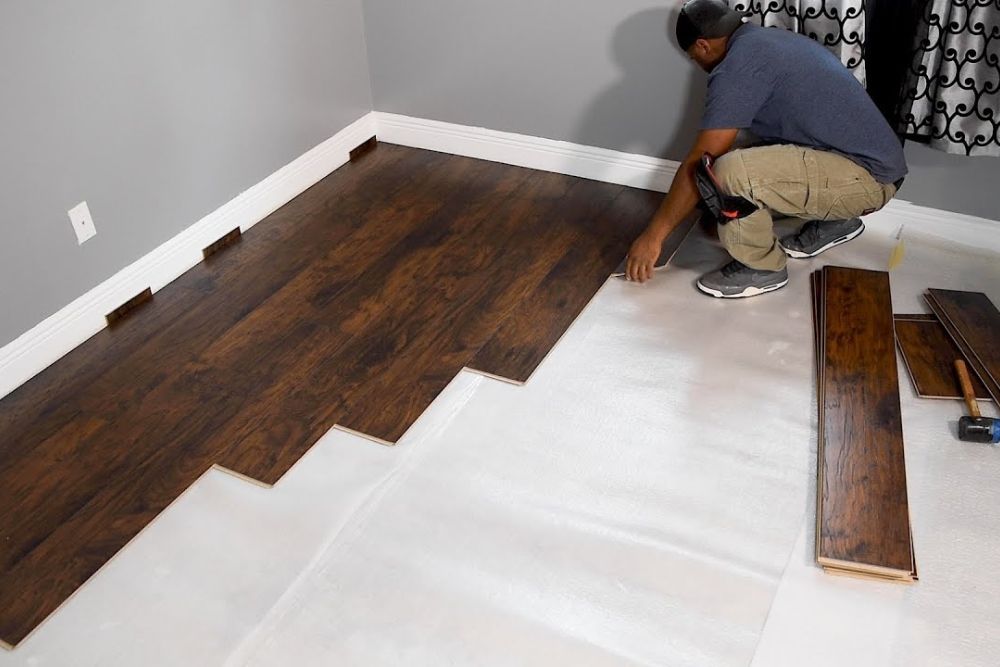
- admin
- Comments 0
- 06 Feb 2025
Laminate Flooring Installation: Laminate flooring is popular with homes because it is cheap, lasts a long time, and is easy to put down. This guide will show you how to put laminate flooring step by step, so even if you’re not very good at DIY, you’ll get a professional-looking result.
Easy Steps for Quick Laminate Flooring Installation
If you follow these simple steps, laminate flooring Installation will be easy and quick. The instructions in this guide will help you finish the job quickly and correctly.
Gather Your Tools and Materials
- Laminate flooring planks
- Underlayment (if required)
- Spacers, measuring tape, and pencil
- Saw (circular or jigsaw), tapping block, pull bar, and hammer
- Utility knife, vacuum, and broom
Prepare the Subfloor
- Clear the room of furniture and old flooring.
- Clean the subfloor thoroughly, ensuring it is dry, level, and free of debris.
- If the subfloor is uneven, sand down high spots or fill in low areas.
Lay the Underlayment
- Roll out the underlayment across the entire floor, making sure it fits snugly without overlapping.
- Tape the seams to secure the underlayment in place.
Start with the First Row
- Place spacers along the walls to create an expansion gap.
- Lay the first row of planks with the tongue side facing the wall.
- Connect the planks end to end, ensuring they are aligned and snug.
Continue the Installation
- Start the second row by cutting a plank to create a staggered pattern.
- Connect each plank by angling the tongue into the groove and tapping it gently with a tapping block.
- Maintain the expansion gap and stagger the joints as you progress.
Finish the Final Row
- Measure and cut the planks for the final row to fit against the wall.
- Use a pull bar to snugly fit the last planks in place.
- Remove the spacers once the final row is secure.
Add Finishing Touches
- Install baseboards or quarter-round molding to cover the expansion gaps.
- Clean up the area, removing any dust or debris.
- Check for any loose planks or imperfections and make necessary adjustments.
Step-by-Step Detailed Guide for Laminate Flooring Installation
Understanding Laminate Flooring
Laminate flooring is a man-made product with many layers that looks like wood, stone, or other natural materials. It has a wear layer that stops stains and scratches, a photographic layer that makes it look like real stone or wood, a core layer made of high-density fiberboard (HDF) to keep it stable, and a backing layer that keeps water out.
Laminate is a great choice for high-traffic places in your home because the top layer is very durable. Additionally, laminate flooring is less expensive, simpler to clean, and comes in a lot of different styles and patterns. This makes it a flexible choice that can work with a range of design styles and room functions.
Preparing the Room for Installation
First, get rid of all the furniture in the room and, if necessary, take up any flooring that is already there. Look under the floor to see if it’s damaged, uneven, or has any problems with moisture. It’s important that the base is clean, dry, and level within 1/8 inch of being 6 feet long. If the subfloor isn’t level, you might need to sand down high spots or use a leveling compound to fill in low places.
Also, prepare the laminate flooring for installation by leaving it in the room for 48 hours. This gives it time to get used to the temperature and humidity of the room. This helps keep the work from expanding or contracting after it’s done. Lastly, make sure you have everything you need, such as underlayment, spacers, a saw, and measure tools. A smooth and successful installation starts with the right planning.
Installing the Underlayment
Put the flooring down first, making sure it covers the whole floor. Depending on what the maker says, most laminate flooring needs an underlayment. This can be foam, cork, or a mix of the two. Spread the underlayment out and cut it to fit the room. Make sure the sides don’t overlap when you fold them together.
Tape the padding down to keep it in place. If you are putting laminate flooring over a concrete base, you might want to use an underlayment that has a moisture barrier built in or put down a separate plastic vapor barrier first. The subfloor is a very important part of making sure that the laminate flooring feels soft underfoot and stays safe from damage caused by water. It also helps cut down on noise, which makes the floor quieter to walk on.
Laying the First Row
To start, put spacers along the walls to keep a gap (usually about 1/4 inch) between the floor and the wall for growth. This space lets the floor expand and shrink as the humidity and temperature change. Put down the first row of laminate planks along the longest wall, making sure the tongue side faces the wall.
If you need to, cut the tongue off the first row to make the edge clean. Put the planks together end to end, making sure they fit together well and are straight. If you need to, use a tapping block and hammer to gently hit the planks together. The first row is very important because if it’s not lined up right, the whole floor will be off. Take your time to make sure it’s straight and the spaces are right.
Continuing the Laminate flooring Installation
When you’re done with the first row, cut a wood to a different length to begin the second row. This will make a pattern that isn’t straight, which not only looks better but also makes the whole system stronger. Place the tongue of each board into the groove of the first row and angle it into place to connect the second row.
Make sure the planks are locked together firmly with a tapping block. Do this all the way around the room, making sure to keep the pattern of different heights and the space for growth on all the walls. You might have to cut a plank to fit when you get to the end of a row. Don’t forget to use a pull bar to make sure the last plank is tight. You need to be patient and pay close attention to this process, but if you keep at it, you’ll get a smooth, professional finish.
Cutting and Fitting the Final Row
Take into account the growth gap when measuring the width needed for the last row. Use a saw to mark and cut the planks, making sure the cut is straight for a perfect fit. You might need to use a pull bar to lock the last row in place if it is very narrow. Be extra careful when you cut the plastic so that it doesn’t get chipped.
Take out the spacers along the walls once the last row is in place. You can now put up baseboards or quarter-round molding around the room’s edges. These will hide the growth gap. Correctly cutting and fitting the last row is important for a clean, finished look, and it finishes the installation process with care and precision.
Finishing Touches and Cleanup
After putting down the laminate flooring, you should cover the expansion gaps around the room’s edges with baseboards or quarter-round molding. To let the floor move, nail the trim to the wall instead of the floor. Make sure the room is clean by cleaning or sweeping up any trash. Use a dry or slightly wet cloth to wipe down the laminate surface to get rid of any dust or glue left over from the installation.
Lastly, look for any broken planks or other flaws and fix them if you find any. Finishing touches, like putting down transition strips between rooms or different types of flooring, finish off the look. This last step makes sure that your new laminate flooring looks good and is ready to be used right away.
Conclusion
Laminate flooring is a popular and affordable option for homes due to its durability and ease of installation. This guide provides step-by-step instructions for a quick and professional installation of laminate flooring. The process involves gathering tools and materials, cleaning the subfloor, laying the underlayment, laying the first row of planks, connecting the second row, and finishing the final row. Laminate flooring is suitable for high-traffic areas and comes in various styles and patterns. To prepare the room, remove furniture, inspect the floor, and leave the flooring for 48 hours to adjust to the room’s temperature and humidity.
The installation process for laminate flooring involves installing an underlayment, which can be foam, cork, or a mix of the two, and tamping it down. The first row of laminate planks should be laid along the longest wall, with spacers along the walls to maintain growth. The second row should be cut to create a different pattern and locked together with a tapping block. The final row should be cut and fitted correctly, and the room should be cleaned and finished with transition strips or different types of flooring. This ensures a smooth and professional look.


